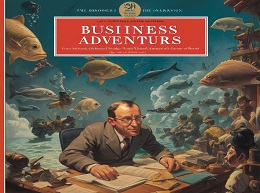The Innovation Stack: Building an Unbeatable Business One Crazy Idea at a Time

"The Innovation Stack": Building Unbeatable Businesses One Crazy Idea at a Time
Jim McKelvey’s "The Innovation Stack: Building an Unbeatable Business One Crazy Idea at a Time" is a compelling narrative that takes readers on a journey through the innovative process that underpinned the success of Square, the financial services and mobile payment company McKelvey co-founded with Jack Dorsey. This book is a blend of autobiography, entrepreneurial guide, and a profound exploration of the power of innovation in building a business that can withstand competition and market changes.
Jim McKelvey
Jim McKelvey is a serial entrepreneur, philanthropist, and artist. Best known as the co-founder of Square, McKelvey has a rich history of innovation and entrepreneurship. His background as a glassblower and his unconventional approach to problem-solving provide a unique perspective that enriches the insights shared in "The Innovation Stack."
Defining the Innovation Stack
At the heart of McKelvey’s book is the concept of the “Innovation Stack,” which he defines as a series of interdependent innovations that build on top of each other, creating a formidable barrier to competition. This stack is not just about a single breakthrough but involves multiple layers of innovations that collectively establish a company’s competitive advantage.
Example: Square’s Payment Processing
When Square was founded, traditional payment processing systems were complicated and expensive. Square’s first innovation was the small, easy-to-use card reader that plugged into a smartphone. But to support this, they had to develop numerous other innovations, including software for transaction processing, fraud detection algorithms, and a new pricing model. Each innovation built upon the previous ones, creating a robust and cohesive system that competitors found difficult to replicate.
The First Crazy Idea
McKelvey emphasizes that every innovation stack begins with a single, often crazy idea. This initial idea doesn’t have to be perfect or complete; it simply needs to address a real problem and be feasible enough to pursue. The initial idea for Square came from McKelvey’s frustration with not being able to accept credit card payments as a small business owner.
Example: Solving a Personal Pain Point
McKelvey’s experience as a glass artist who lost a sale because he couldn’t accept credit cards led to the creation of Square. This personal pain point was the catalyst for the first layer of the innovation stack.
Adding Layers to the Stack
As the business grows, new challenges emerge, requiring additional innovations. These layers are interdependent, meaning that each new innovation relies on the successful implementation of the previous ones. This process creates a unique and complex system that competitors find difficult to copy.
Example: Scaling and Security
To scale Square, McKelvey and Dorsey had to innovate in areas such as security, ease of use, and regulatory compliance. They developed advanced encryption methods to secure transactions, a user-friendly interface that made the service accessible to non-technical users, and a legal framework that allowed them to operate within the stringent financial regulations.
Historical Examples of Innovation Stacks
McKelvey draws on historical examples to illustrate how innovation stacks have been used to build dominant businesses. He discusses companies like Bank of America and Southwest Airlines, showing how their layers of innovation created strong competitive advantages.
Example: Bank of America’s Branch Banking
Bank of America started as a small bank in San Francisco but grew to become a national powerhouse by continually innovating in areas like branch banking, customer service, and credit cards. Each of these innovations built on the previous ones, creating a formidable financial institution.
Coping with Copycats
One of the key insights McKelvey shares is that true innovation is difficult to copy. When competitors try to replicate an innovation stack, they often miss the nuances and interdependencies that make the original system work. This makes the original company’s position more secure.
Example: Square vs. Amazon
Amazon attempted to enter the mobile payments space with a product similar to Square’s. Despite Amazon’s vast resources, they were unable to replicate the complex interdependencies of Square’s innovation stack, leading to their eventual withdrawal from the market.
Embracing Uncertainty
McKelvey encourages entrepreneurs to embrace uncertainty and take risks. He argues that waiting for the perfect idea or perfect timing can result in missed opportunities. Instead, entrepreneurs should start with a feasible idea and be willing to innovate continuously.
Example: Iterative Development
McKelvey and Dorsey didn’t wait for Square to be perfect before launching it. They started with a basic product and improved it over time based on user feedback and emerging challenges. This iterative approach allowed them to adapt quickly and stay ahead of the competition.
Building a Resilient Team
Building an innovation stack requires a team that is adaptable, creative, and resilient. McKelvey stresses the importance of hiring people who are not only skilled but also passionate about solving problems and willing to think outside the box.
Example: Square’s Diverse Team
Square’s success can be attributed in part to its diverse team of engineers, designers, and business experts. This diversity brought a wide range of perspectives and ideas, enabling the company to innovate across multiple dimensions.
Continuous Evolution
McKelvey concludes by emphasizing that innovation is an ongoing process. Companies must continually evolve their innovation stacks to address new challenges and seize new opportunities. This requires a culture of continuous improvement and a willingness to embrace change.
Example: Adapting to Market Changes
Square has continued to evolve its products and services, expanding into areas like business loans and payroll services. By continually adding new layers to its innovation stack, Square has maintained its competitive edge and continued to grow.
"The Innovation Stack: Building an Unbeatable Business One Crazy Idea at a Time" by Jim McKelvey is an enlightening and inspiring read for entrepreneurs, business leaders, and anyone interested in the process of innovation. Through engaging stories and practical advice, McKelvey demystifies the concept of building an innovation stack and illustrates how a series of interconnected innovations can create a powerful competitive advantage.
By focusing on real-world examples, historical insights, and practical guidance, McKelvey provides a roadmap for building a resilient and innovative business. Whether you are starting a new venture or looking to drive innovation within an established company, "The Innovation Stack" offers valuable lessons and inspiration for creating a business that can thrive in the face of competition and market changes.
In a world where innovation is often touted as the key to success, McKelvey’s book provides a concrete framework for understanding and implementing it. "The Innovation Stack" is a must-read for anyone looking to turn crazy ideas into reality and build a business that can stand the test of time.













